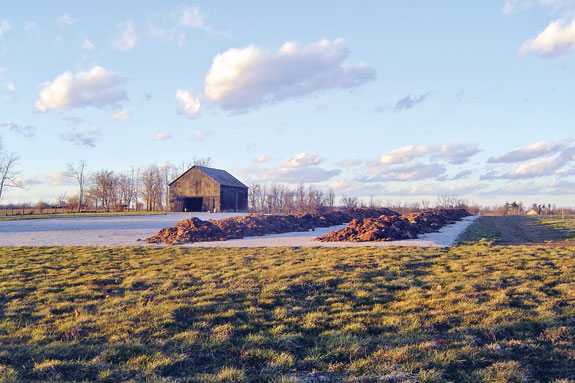Your options for disposal of dead cattle and other farm animals are typically burial, incineration, rendering and taking it to a landfill.
Composting, however, just may be the best option for you and the environment.
Stephen Higgins, director of environmental compliance for the agricultural experiment station for the University of Kentucky, says you can’t beat the costs and environmental benefits when it comes to composting.
How to compost cattle
According to Higgins, the first step needed is finding a carbon source. “The best carbon sources you can get are wood products,” he says. As far as types of wood products, he suggests wood shavings, sawdust and wood chips.
Of the three types of wood carbon sources, he says wood shavings will work best. Wood chips – larger- sized chips – usually have too much air that moves through the pile and wood shavings will take care of that problem.
“For a 1,000-pound animal you will need to build what is called a bed,” he says. You should place the animal on about three feet of your chosen carbon source.
Then you’ll need at least three feet of material covering the animal and about two feet on each side.
Higgins says wood chips are basically beneficial bacteria and they act as a “biofilter” to break down the long molecules of the complex decomposition gases emitted from the animal.
The bacteria are going to respire and give off some carbon dioxide. It will give off a very small hint of ammonia, and that’s about it.
“After the bed is built up, microbial and beneficial bugs will begin decomposing the carcass,” he says. A lot of heat is generated in the process, which kills harmful pathogens. The heat that is generated actually speeds up the process, too.
Higgins says they’re able to consistently compost a 1000-pound carcass to near entirety in six weeks. The only material left may be a few large bones, but there will be no blood or flesh on them. Some of them may even break up like chalk.

Why compost?
So, why compost rather than burial, incineration, rendering or taking cattle to a landfill?
According to John Settles, a cattle composter in Kentucky, if you have your cattle picked up and brought to a landfill, you’re just taking up valuable space in the landfill.
“You would think the animal would compost just the way it does when we do it, but it really just decays and adds to the whole filth and stench of a landfill,” Settles says.
Higgins says incineration isn’t practical. “If you have a 1,000-pound beef cow carcass and it’s 70 percent water, that means you’ll have to drive off 700 pounds of moisture before you can start to ash the animal,” he says. That would use a lot of fuel and would not be cost-efficient.
“Burial is another option, but there are many environmental regulations and it’s hard to have control of the soil underground, which can pollute groundwater,” Higgins says.
In Kentucky, officials also recommend covering the animal with quicklime. However, quicklime reacts with moisture, heats up and causes a chemical reaction that skyrockets pH. Harmful pathogens are killed, but so are necessary bacteria for decomposition.
Higgins says when you render dead cattle, it is required that you remove the brain and spinal cord first, which could be an obstacle for disposing your cattle.

Finding a carbon source to compost cattle
According to Settles, there are numerous tree removal services that are always looking to dispose their wood shavings; otherwise they have to pay a landfill to dump them.
“We also take used bedding material from surrounding feedlots,” he said. They typically use sawdust and straw. “The drier the material, the better,” he says.
According to Ryan Conboy, owner of Conboy Enterprises, LLC, a composting company in Kentucky, you can also take manure from the feedlots. Again, the drier the material the better.
Conboy believes composting is a much more environmentally friendly way of disposing livestock and just built a one-acre composting pad in Kentucky.
“We’ll eventually use the fully composted material to spread in our corn and bean fields,” he said.
Benefits of composting
Settles says composting is just about as “green” as you can get. “You’re taking free organic material and a deceased animal and it’s essentially turning into a natural, reusable state,” he said.
According to Settles, the composted material can be reused to compost more cattle. “Once the material is very fine and isn’t nearly as efficient for composting, the material can be sold as a soil additive – or we’d probably just give it away,” he said.
Settles said there’s also no smell. “That’s why everybody is so amazed,” he says. The high temperature of the pile keeps away varmints and flies too.
He added that “it’s a really clean process for something that sounds so objectionable.”
Settles also has a compost truck driver with his own cell phone number advertised to the community producers in his county. Producers can have their dead cattle picked up for just $20 every time he comes by.
Need a permit
Higgins says in Kentucky you currently need a permit to compost, but laws are liable to change soon that will allow composting to be done without a permit on agricultural operations.
“Commercially, someone who picks up cattle to do the composting for you will likely need a permit,” he said.
According to Ted McCollum, professor and extension beef cattle specialist in Amarillo for Texas A&M, feedlots and ranchers do not need a permit to compost their cattle on their own property in Texas.
However, if a neighbor asked to have you compost his cattle on your land, you’d need a permit.
Sandy Johnson, livestock specialist for Kansas State University, says size determines the need for a permit in Kansas.
If the composting site is less than a half-acre, then you’ll need to register. Larger operations will need a permit.
Jim Sullins, county director for the University of California Cooperative Extension, says composting mammalian tissue is currently illegal in California.
In fact, he said state laws had to be changed to allow composting research to be done.
Regulations vary from state to state. To be safe, you’ll want to call your department of heath and environmental safety.
Composting points to keep in mind
Higgins says that, ideally, you don’t want to exceed a pile temperature of 155 degrees because it will usually destroy beneficial bacteria.
“At times, temperatures can get near 180 degrees and people will think they should stir the pile up,” he says.
You should really just “let the pile ride out the process, because stirring too soon will expose material on the outside of the pile and attract vermin.
“I’ve seen piles covered in snow before and we found that those piles were still 165 degrees in the middle, which is amazing without question,” he says.
Higgins also recommends that you should not “skimp” on carbon materials when you compost your animals.
For example, if you use 18 inches of bedding under the animal and minimal amounts on top rather than three feet, then you will see a lot of liquid eluding and odors can escape.
“Around the fifth day, you’ll see about 35-50 gallons of liquid eluding from the pile,” he explains.
Remember, a 1,000-pound carcass is about 70 percent water. Having adequate carbon material will contain the liquids and help destroy odors.
Higgins says you need to use common sense when selecting a site. “I would prefer hilltop positions, not in a flood plain or near ponds and creeks,” he says. Use standard manure application setbacks.
“If you’re doing it right, nobody will even know you’re doing it,” he says. ![]()
PHOTOS
Facilities like the Conboy Enterprises composting pad in Kentucky can take dry manure from feedlots to compost carcasses, and then apply to crop fields. Photos courtesy of Ryan Conboy.







